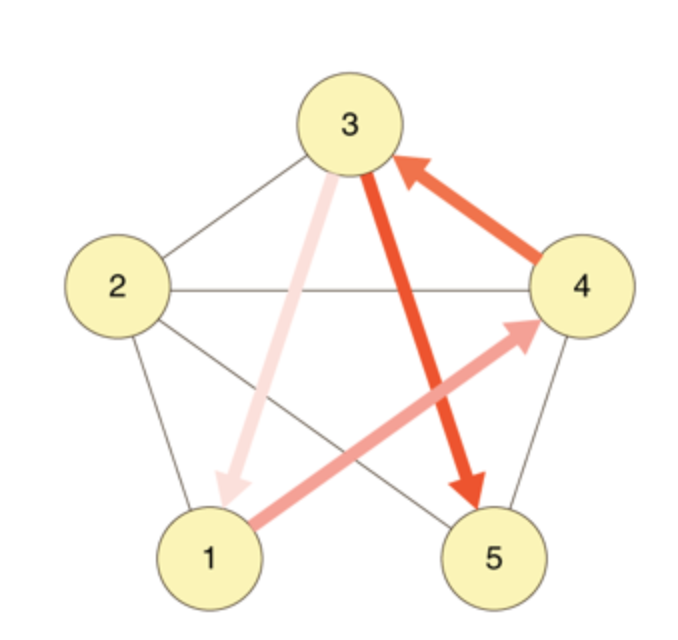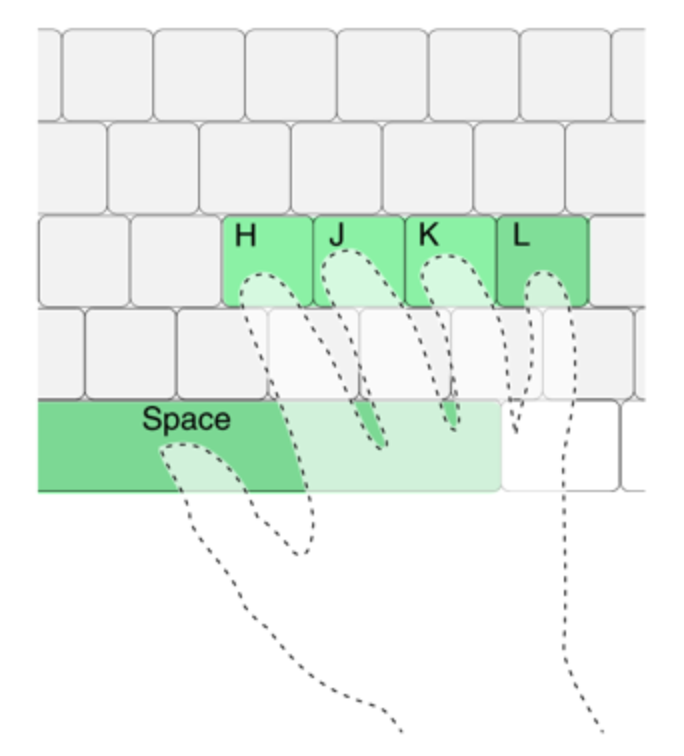Lab interests…
We study biological, physical, and social systems by using and developing tools from network science and complex systems theory. Our broad goal is to isolate problems at the intersection of basic science, engineering, and clinical medicine that can be tackled using systems-level approaches.
Curiosity
Shubhankar P. Patankar, Dale Zhou, Christopher W. Lynn, Jason Z. Kim, Mathieu Ouellet, Harang Ju, Perry Zurn, David M. Lydon-Staley, Dani S. Bassett. Curiosity as filling, compressing, and reconfiguring knowledge networks. 2022, arXiv:2204.01182.
Harang Ju, Dale Zhou, Ann S. Blevins, David M. Lydon-Staley, Judith Kaplan, Julio R. Tuma, Dani S. Bassett. The network structure of scientific revolutions. Collective Intelligence, 2022, In Press. Preprint also available here: arXiv:2010.08381.
David M. Lydon-Staley, Dale Zhou, Ann S. Blevins, Perry Zurn, Dani S. Bassett. Hunters, busybodies and the knowledge network building associated with deprivation curiosity. Nat Hum Behav. 2021, 5(3):327-336.
Perry Zurn, Dani S. Bassett. Network architectures supporting learnability. Philos Trans R Soc Lond B Biol Sci. 2020, 375(1796):20190323.
Dale Zhou D, David M. Lydon-Staley, Perry Zurn, Dani S. Bassett. The growth and form of knowledge networks by kinesthetic curiosity. Curr Opin Behav Sci. 2020, 35:125-134.
Perry Zurn, Dani S. Bassett. Seizing an opportunity. Elife. 2019, 8:e48336.
David M. Lydon-Staley, Perry Zurn, Dani S. Bassett. Within-person variability in curiosity during daily life and associations with well-being. J Pers. 2020 Aug;88(4):625-641.
Perry Zurn & Dani S. Bassett. On curiosity: a fundamental aspect of personality, a practice of network growth. Personality Neuroscience. 2018. 1:e13.
Dani S. Bassett. A network science of the practice of curiosity. In the collected volume “Curiosity Studies: Toward a New Ecology of Knowledge,” Minnesota Press, edited by Perry Zurn & Arjun Shankar.
Knowledge Networks: Architecture & Learnability
Network Architecture of Knowledge:
Lucy R. Chai, Danielle S. Bassett. Evolution of semantic networks in biomedical texts. Preprint available on arxiv.
Jordan D. Dworkin, Russell T. Shinohara, Danielle S. Bassett. The landscape of NeuroImage-ing research. NeuroImage, 2018,183:872-883.
Jordan D. Dworkin, Russell T. Shinohara, Danielle S. Bassett. The emergent integrated network structure of scientific research. 2018, In Review.
Ann E. Sizemore, Elisabeth A. Karuza, Chad Giusti, Danielle S. Bassett. Knowledge gaps in the early growth of semantic networks. Nature Human Behavior, 2018, 2(9):682-692.
Graph Learnability:
Christopher W. Lynn, Ari E. Kahn, Danielle S. Bassett. Structure from noise: Mental errors yield abstract representations of events. 2018, In Review.
Ari E. Kahn, Elisabeth A. Karuza, Jean M. Vettel, Danielle S. Bassett. Network constraints on learnability of probabilistic motor sequences. 2018, Epub Ahead of Print.
Steven H. Tompson, Ari E. Kahn, Emily B. Falk, Jean M. Vettel, Danielle S. Bassett. Individual differences in learning social and nonsocial network structures. J Exp Psychol Learn Mem Cogn. 2018 Jul 19. [Epub ahead of print]
Elisabeth A. Karuza, Ari E. Kahn, Sharon L. Thompson-Schill, Danielle S. Bassett. Process reveals structure: How a network is traversed mediates expectations about its architecture. Sci Rep. 2017 Oct 6;7(1):12733.
Elisabeth A. Karuza, Sharon L. Thompson-Schill, Danielle S. Bassett. Local Patterns to Global Architectures: Influences of Network Topology on Human Learning. Trends Cogn Sci. 2016 Aug;20(8):629-640.
Controllability of Brain Networks
The network architecture of the structural connectome forms a critical backbone on which cognitive processes evolve. In this project, we seek to build a theoretical framework in which to understand the impact of white matter microstructure and its large-scale interconnections patterns on the cognitive roles of brain areas, individual differences in cognitive function, and the effects of external stimulation on brain dynamics. In these efforts, we draw on both classical and cutting-edge tools in network control theory.
Recent Reviews
Evelyn Tang, Danielle S. Bassett. Control of Dynamics in Brain Networks. Reviews of Modern Physics. 90, 031003 – Published 14 August 2018.
Bassett DS, Khambhati AN. A network engineering perspective on probing and perturbing cognition with neurofeedback. Ann N Y Acad Sci. 2017 May;1396(1):126-143.
Network Control Theory:
Kim JZ, Soffer JM, Kahn AE, Vettel JM, Pasqualetti F, Bassett DS. Role of Graph Architecture in Controlling Dynamical Networks with Applications to Neural Systems. Nat Phys. 2018;14:91-98.
Network Control and Cognitive Neuroscience:
Shi Gu, Richard F. Betzel, Matthew Cieslak, Philip Delio, Scott T. Grafton, Fabio Pasqualetti, Danielle S. Bassett. Optimal Trajectories of Brain State Transitions. Neuroimage. 2017 Mar 1;148:305-317.
Richard F. Betzel, Shi Gu, John D. Medaglia, Fabio Pasqualetti, Danielle S. Bassett. Optimally controlling the human connectome: the role of network topology. Scientific Reports. 2016 Jul 29;6:30770.
Shi Gu, Fabio Pasqualetti, Matthew Cieslak, Qawi Telesford, Alfred Yu, Ari Kahn, John D. Medaglia, Jean Vettel, Michael B. Miller, Scott T. Grafton, Danielle S. Bassett. Controllability of Structural Brain Networks. Nature Communications, 2015, 6:8414.
John D. Medaglia, Shi Gu, Fabio Pasqualetti, Rebecca L. Ashare, Caryn Lerman, Joseph Kable, Danielle S. Bassett. Cognitive Control in the Controllable Connectome. Submitted.
Network Control and Clinical Neuroscience:
Jeganathan J, Perry A, Bassett DS, Roberts G, Mitchell PB, Breakspear M. Fronto-limbic dysconnectivity leads to impaired brain network controllability in young people with bipolar disorder and those at high genetic risk. Neuroimage Clin. 2018 Mar 27;19:71-81.
Shi Gu, Richard F. Betzel, Matthew Cieslak, Philip Delio, Scott T. Grafton, Fabio Pasqualetti, Danielle S. Bassett. Optimal Trajectories of Brain State Transitions. Neuroimage. 2017 Mar 1;148:305-317.
Network Control and Stimulation
Medaglia JD, Harvey DY, White N, Kelkar A, Zimmerman J, Bassett DS, Hamilton RH. Network Controllability in the Inferior Frontal Gyrus Relates to Controlled Language Variability and Susceptibility to TMS. J Neurosci. 2018 Jul 11;38(28):6399-6410.
Sarah F. Muldoon, Fabio Pasqualetti, Shi Gu, Matthew Cieslak, Scott T. Grafton, Jean M. Vettel, Danielle S. Bassett. Stimulation-based control of dynamic brain networks. PLoS Comp Biol. 2016 Sep 9;12(9):e1005076.
Network Control Applied to Cellular-Level Neural Circuits
Wiles L, Gu S, Pasqualetti F, Parvesse B, Gabrieli D, Bassett DS, Meaney DF. Autaptic Connections Shift Network Excitability and Bursting. Sci Rep. 2017 Mar 7;7:44006.

Dynamic Networks in Neuroscience
Neurophysiological processes -- from learning and memory to disease and response to injury -- are inherently dynamic processes. A major thrust of our group lies in developing mathematical tools for understanding how brain networks reconfigure over multiple time scales. We apply these tools to understand executive function, human learning, lexical processing, motor behavior, and psychiatric disease.
Dynamic Network Methods
Danielle S. Bassett, Mason A. Porter, Nicholas F. Wymbs, Scott T. Grafton, Jean M. Carlson, Peter J. Mucha. Robust detection of dynamic community structure in networks. Chaos, 2013, 23, 1.
Danielle S. Bassett, Nicholas F. Wymbs, Mason A. Porter, Peter J. Mucha, Scott T. Grafton. Cross-linked structure of network evolution.Chaos, 2014, 24(1):013112.
Ankit N Khambhati, Marcelo G Mattar, Danielle S Bassett. Beyond modularity: Fine-scale mechanisms and rules for brain network reconfiguration. Submitted.
Ankit N Khambhati, Ann E Sizemore, Richard F Betzel, Danielle S Bassett. Modelling And Interpreting Network Dynamics. Submitted.
Arian Ashourvan, Shi Gu, Marcelo G. Mattar, Jean M. Vettel, Danielle S. Bassett. The Energy Landscape Underpinning Module Dynamics in the Human Brain Connectome. Neuroimage. 2017. In Press.
Arian Ashourvan, Qawi K. Telesford, Timothy Verstynen, Jean M. Vettel, Danielle S. Bassett. Multi-scale detection of hierarchical community architecture in structural and functional brain networks. Submitted.
Gu S, Yang M, Medaglia JD, Gur RC, Gur RE, Satterthwaite TD, Bassett DS. Functional hypergraph uncovers novel covariant structures over neurodevelopment. Hum Brain Mapp. 2017 May 11.
Dynamic Networks and Mood:
Richard F. Betzel, Theodore D. Satterthwaite, Joshua I. Gold, Danielle S. Bassett. Positive affect, surprise, and fatigue are correlates of network flexibility. Sci Rep. 2017 Mar 31;7(1):520.
Dynamic Networks in Executive Function:
Urs Braun, Axel Schaefer, Henrik Walter, Susanne Erk, Nina Romanczuk-Seiferth, Leila Haddad, Janina Schweiger, Oliver Grimm, Andreas Heinz, Heike Tost, Andreas Meyer-Lindenberg, Danielle S. Bassett. Dynamic Reconfiguration of Frontal Brain Networks During Executive Cognition in Humans. PNAS, 2015, 112(37):11678-83.
Braun U, Schäfer A, Bassett DS, Rausch F, Schweiger JI, Bilek E, Erk S, Romanczuk-Seiferth N, Grimm O, Geiger LS, Haddad L, Otto K, Mohnke S, Heinz A, Zink M, Walter H, Schwarz E, Meyer-Lindenberg A, Tost H. Dynamic brain network reconfiguration as a potential schizophrenia genetic risk mechanism modulated by NMDA receptor function. Proc Natl Acad Sci U S A. 2016 Nov 1;113(44):12568-12573.
Lucy Chai, Ankit Khambhati, Rastko Ciric, Tyler Moore, Ruben Gur, Raquel Gur, Theodore D. Satterthwaite, Danielle S. Bassett. Evolution of brain network dynamics in neurodevelopment. Network Neuroscience, 1(1) 14-30, 2017.
Dynamic Networks in Learning:
Danielle S. Bassett, Nicholas Wymbs, Mason Alexander Porter, Peter Mucha, Jean M. Carlson, Scott T. Grafton. Dynamic reconfiguration of human brain networks during learning. PNAS, 2011, 108(18):7641-6.
Alexander V. Mantzaris, Danielle S. Bassett, Nicholas F. Wymbs, Ernesto Estrada, Mason A. Porter, Peter J. Mucha, Scott T. Grafton, Desmond J. Higham. Dynamic network centrality summarizes learning in the human brain. Journal of Complex Networks, 2013, 1(1):83-92.
Danielle S. Bassett, Nicholas F. Wymbs, M. Puck Rombach, Mason A. Porter, Peter J. Mucha, Scott T. Grafton. Task-Based core-periphery organisation of human brain dynamics. PLoS Comp Biol, 2013, 9(9): e1003171.
Danielle S. Bassett, Muzhi Yang, Nicholas F. Wymbs, Scott T. Grafton. Learning-induced autonomy of sensorimotor systems. Nature Neuroscience, 2015, 18(5):744-51.
Raphael T. Gerraty, Juliet Y. Davidow, Karin Foerde, AdrianaGalvan, Danielle S. Bassett, Daphna Shohamy. Dynamic flexibility in striatal-cortical circuits supports reinforcement learning. Submitted.
Marcelo Mattar, Nicholas F Wymbs, Andrew S Bock, Geoffrey K Aguirre, Scott T Grafton, Danielle S Bassett. Predicting future learning from baseline network architecture. Submitted.
Marcelo G Mattar, Sharon L Thompson-Schill, Danielle S Bassett. The network architecture of value learning. Submitted.
Pranav G. Reddy, Marcelo G. Mattar, Andrew C. Murphy, Nicholas F. Wymbs, Scott T. Grafton, Theodore D. Satterthwaite, Danielle S. Bassett. Brain State Flexibility Accompanies Motor-Skill Acquisition. Submitted.
Dynamic Networks in Multi-Task Scenarios:
Michael W. Cole, Danielle S. Bassett, Jonathan D. Power, Tod S. Braver, Steve E. Petersen. Intrinsic and task-evoked network architectures of the human brain. Neuron, 2014, 83(1):238-51.
Elizabeth N. Davison, Kimberly J. Schlesinger, Danielle S. Bassett, Mary-Ellen Lynall, Michael B. Miller, Scott T. Grafton, Jean M. Carlson. Brain network adaptability across task states. PLoS Comput Biol, 2015,11(1):e1004029.
Marcelo G. Mattar, Michael W. Cole, Sharon L. Thompson-Schill, Danielle S. Bassett. A Functional Cartography of Cognitive Systems. PLoS Comput Biol. 2015 Dec 2;11(12):e1004533.
Davison EN, Turner BO, Schlesinger KJ, Miller MB, Grafton ST, Bassett DS, Carlson JM. Individual Differences in Dynamic Functional Brain Connectivity across the Human Lifespan. PLoS Comput Biol. 2016 Nov 23;12(11):e1005178.
Cole MW, Ito T, Bassett DS, Schultz DH. Activity flow over resting-state networks shapes cognitive task activations. Nat Neurosci. 2016 Dec;19(12):1718-1726.
Dynamic Networks in Lexical Processing:
Karl W. Doron, Danielle S. Bassett, Michael S. Gazzaniga. Dynamic network structure of interhemispheric coordination. PNAS, 2012, 109 (46) 18627-18628.
Lucy Chai, Marcelo Mattar, Idan Asher Blank, Evelina Fedorenko, Danielle S. Bassett. Functional Network Dynamics of the Language System. Cereb Cortex. 2016 Oct 17;26(11):4148-4159.
Dynamic Networks in Motor Behavior:
Nicholas F. Wymbs, Danielle S. Bassett, Peter J. Mucha, Mason A. Porter and Scott T. Grafton. Differential recruitment of the sensorimotor putamen and frontoparietal cortex during motor chunking in humans. Neuron, 2012, 74(5):936-946.
Dynamic Networks in Psychiatric Disease:
Felix Siebenhuhner, Shennan A. Weiss, Richard Coppola, Daniel R. Weinberger, Danielle S. Bassett. Intra- and inter-frequency brain network structure in health and schizophrenia. PLoS ONE 8(8): e72351.
Braun U, Schäfer A, Bassett DS, Rausch F, Schweiger JI, Bilek E, Erk S, Romanczuk-Seiferth N, Grimm O, Geiger LS, Haddad L, Otto K, Mohnke S, Heinz A, Zink M, Walter H, Schwarz E, Meyer-Lindenberg A, Tost H. Dynamic brain network reconfiguration as a potential schizophrenia genetic risk mechanism modulated by NMDA receptor function. Proc Natl Acad Sci U S A. 2016 Nov 1;113(44):12568-12573.
Dynamic Networks in Neurological Disorders:
Ankit Khambhati, Kathryn Davis, Timothy Lucas, Brian Litt, Danielle S. Bassett. Dynamic network drivers of seizure generation,
propagation and termination in human epilepsy. PLoS Comput Biol. 2015 Dec 17;11(12):e1004608.Khambhati AN, Bassett DS, Oommen BS, Chen SH, Lucas TH, Davis KA, Litt B. Recurring Functional Interactions Predict Network Architecture of Interictal and Ictal States in Neocortical Epilepsy. eNeuro. 2017 Mar 8;4(1). pii: ENEURO.0091-16.2017.
Khambhati AN, Davis KA, Lucas TH, Litt B, Bassett DS. Virtual Cortical Resection Reveals Push-Pull Network Control Preceding Seizure Evolution Neuron. 2016 Sep 7;91(5):1170-82.
Network Physics of Soft (and Biological) Materials
Granular materials have been modeled from continuum and particulate perspectives but neither approach explains their complex behaviors. A network representation allows one to consider both microscopic and long-range features in the form of force chains. We study granular materials as spatially-embedded networks in which the nodes (particles) are connected by weighted edges (contact forces). Using photoelastic particles, we examine the importance of meso-scale network features to the understanding of sound propagation in this medium. Our work demonstrates how the pressure state of a granular system is imprinted on transmitted waves. This fundamental physics can be used for material characterization and non-destructive testing.
Granular Materials
Lia Papadopoulus, James Puckett, Karen E. Daniels, Danielle S. Bassett. Evolution of network architecture in a granular material under compression. Phys Rev E. 2016 Sep;94(3-1):032908. Epub 2016 Sep 23.
Giusti C, Papadopoulos L, Owens ET, Daniels KE, Bassett DS. Topological and geometric measurements of force-chain structure. Phys Rev E. 2016 Sep;94(3-1):032909. Epub 2016 Sep 28.
Danielle S. Bassett, Eli T. Owens, Mason A. Porter, Lisa M. Manning, Karen E. Daniels. Extraction of force-chain network architecture in granular materials using community detection. Soft Matter, 2015, 11(14):2731-44.
Danielle S. Bassett, Eli T. Owens, Karen E. Daniels, Mason A. Porter. The influence of topology on sound propagation in granular force networks. Phys Rev E, 2012, 86, 041306.
Biological Materials
Sijia Zhang, Danielle S. Bassett, Beth Winkelstein. Stretch-induced network reconfiguration of collagen fibers in the human facet capsular ligament. J R Soc Interface. 2016 Jan;13(114):20150883.
Lia Papadopoulos, Pablo Blinder, Henrik Ronellenfitsch, Florian Klimm, Eleni Katifori, David Kleinfeld, Danielle S. Bassett. Embedding of biological distribution networks with differing environmental constraints. Submitted.

Organization of Large-Scale Brain Circuitry
The human brain is a complex system for which a combination of mathematical modeling and time series analysis enables the prediction of system behavior, facilitating a direct feedback loop between theory and experiment. We examine structural and functional brain networks using data from non-invasive neuroimaging techniques (fMRI, MEG, MRI, DTI, DSI). Our goal is to determine fundamental organizational principles of both underlying structure and functional dynamics. Our results collectively point to principles of structural network efficiency, spatial and temporal scaling of network organization, and network adaptability in response to increasing cognitive demands or in the context of learning. Importantly, complementary evidence from psychiatric disease, specifically schizophrenia, highlights the disruption of normal connectivity patterns, the prevalence of wiring inefficiency, and the relationship between efficient network organization and cognitive fitness.
Recent Papers
Baum GL, Ciric R, Roalf DR, Betzel RF, Moore TM, Shinohara RT, Kahn AE, Vandekar SN, Rupert PE, Quarmley M, Cook PA, Elliott MA, Ruparel K, Gur RE, Gur RC, Bassett DS, Satterthwaite TD. Modular Segregation of Structural Brain Networks Supports the Development of Executive Function in Youth. Curr Biol. 2017 Jun 5;27(11):1561-1572.e8.
Shi Gu, Theodore Satterthwaite, John Medaglia, Muzhi Yang, Raquel Gur, Ruben Gur, Danielle S. Bassett. Emergence of System Roles in Normative Neurodevelopment. PNAS. Early Edition, Oct 20, 2015.
Ann M. Hermundstad, Kevin S. Brown, Danielle S. Bassett, Elissa M. Aminoff, A. Frithsen, A. Johnson, Christine M. Tipper, Michael B. Miller, Scott T. Grafton, Jean M. Carlson. Structurally-constrained relationships between cognitive states in the human brain. PLoS Comput Biol, 2014, 10(5):e1003591.
Ann M. Hermundstad, Danielle S. Bassett, Kevin S. Brown, Elissa M. Aminoff, David Clewett, Scott Freeman, Amy Frithsen, Arianne Johnson, Christine Tipper, Michael B. Miller, Scott T. Grafton, Jean M. Carlson. Structural foundations of resting-state and task-based neural activity in the human brain. PNAS 110(15):6169-74.
Danielle S. Bassett, Jesse A. Brown, Vibhas Deshpande, Jean M. Carlson, Scott A. Grafton. Conserved and variable architecture of human white matter connectivity. Neuroimage, 2011, 54(2):1262-1279.
Danielle S. Bassett, Daniel L. Greenfield, Andreas Meyer-Lindenberg, Daniel R. Weinberger, Simon W. Moore, Edward T. Bullmore. Efficient physical embedding of topologically complex information processing networks in brains and computer circuits. PloS Comp Biol, 2010, 6(4):e1000748.
Danielle S. Bassett, Edward T. Bullmore, Andreas Meyer-Lindenberg, Jose A. Apud, Daniel R. Weinberger, Richard Coppola. Cognitive fitness of cost-efficient brain functional networks. Proc Natl Acad Sci U S A, 2009, 106(28):11747-52
Large-Scale Brain Circuitry in Psychiatric Disease
Schizophrenia is a devastating psychiatric disorder characterized by alterations in a distributed set of brain areas. We use network methods to uncover changes in large-scale brain circuitry that impact on cognitive function and behavior with the goal of identifying underlying neurophysiological processes of the disease and informing clinical interventions including cognitive remediation.
Recent Papers
Sharma A, Wolf DH, Ciric R, Kable JW, Moore TM, Vandekar SN, Katchmar N, Daldal A, Ruparel K, Davatzikos C, Elliott MA, Calkins ME, Shinohara RT, Bassett DS, Satterthwaite TD. Common Dimensional Reward Deficits Across Mood and Psychotic Disorders: A Connectome-Wide Association Study. Am J Psychiatry. 2017 Jan 31:appiajp201616070774.
Satterthwaite TD, Vandekar SN, Wolf DH, Bassett DS, Ruparel K, Shehzad Z, Craddock RC, Shinohara RT, Moore TM, Gennatas ED, Jackson C, Roalf DR, Milham MP, Calkins ME, Hakonarson H, Gur RC, Gur RE. Connectome-wide network analysis of youth with Psychosis-Spectrum symptoms. Mol Psychiatry. 2015 Dec;20(12):1508-15.
Satterthwaite TD, Kable JW, Vandekar L, Katchmar N, Bassett DS, Baldassano CF, Ruparel K, Elliott MA, Sheline YI, Gur RC, Gur RE, Davatzikos C, Leibenluft E, Thase ME, Wolf DH. Common and Dissociable Dysfunction of the Reward System in Bipolar and Unipolar Depression Neuropsychopharmacology. 2015 Aug;40(9):2258-68.
Felix Siebenhuhner, Shennan A. Weiss, Richard Coppola, Daniel R. Weinberger, Danielle S. Bassett. Intra- and inter-frequency brain network structure in health and schizophrenia. PLoS ONE 8(8): e72351.
Danielle S. Bassett, Brent G. Nelson, Bryon A. Mueller, Jazmin Camchong, Kelvin O. Lim. Abnormal resting state complexity in schizophrenia. Neuroimage, 2012, 59(3):2196-207.
Shennan Aibel Weiss, Danielle S. Bassett, Daniel Rubinstein, Tom Holroyd, Jose Apud, Dwight Dickinson, Richard Coppola. Functional brain network characterization and adaptivity during task practice in healthy volunteers and people with schizophrenia. Front. Hum. Neurosci, 2011, 5:81.
Mary-Ellen Lynall, Danielle S. Bassett, Peter J. McKenna, Manfred Kitzbichler, Ulrich Muller, and Edwart T. Bullmore. Functional connectivity and brain networks in schizophrenia. J Neurosci, 2010, 30(28):9477-9487.
Danielle S. Bassett, Edward T. Bullmore, Andreas Meyer-Lindenberg, Jose A. Apud, Daniel R. Weinberger, Richard Coppola. Cognitive fitness of cost-efficient brain functional networks. Proc Natl Acad Sci U S A, 2009, 106(28):11747-52.
Danielle S. Bassett, Edward Bullmore, Beth A. Verchinski, Venkata S. Mattay, Daniel R. Weinberger, Andreas Meyer-Lindenberg. Hierarchical organization of human cortical networks in health and schizophrenia. J Neurosci, 2008, 28(37):9239-48.












